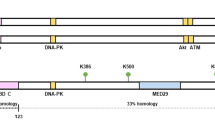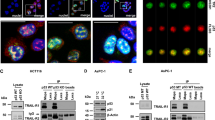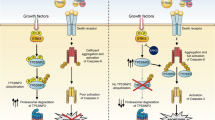Abstract
Both DR4 and DR5 have recently been identified as membrane death receptors that are activated by their ligand TRAIL to engage the intracellular apoptotic machinery. TRID (also named as TRAIL-R3) is an antagonist decoy receptor and lacks the cytoplasmic death domain. TRID protects from TRAIL-induced apoptosis by competing with DR4 and DR5 for binding to TRAIL. TRID has been shown to be overexpressed in normal human tissues but not in malignantly transformed cell lines. DR5 is a p53-regulated gene and we have recently reported that DR5 expression is induced in response to genotoxic stress in both a p53-dependent and independent manner (Sheikh et al., 1998). In the current study, we demonstrate that TRID gene expression is also induced by the genotoxic agents ionizing radiation and methyl methanesulfonate (MMS) in predominantly p53 wild-type cells, whereas UV-irradiation does not induce TRID gene expression. Consistent with these results, exogenous wild-type p53 also upregulates the expression of endogenous TRID in p53-null cells. Thus, TRID appears to be a p53 target gene that is regulated by genotoxic stress in a p53-dependent manner. Using primary gastrointestinal tract (GIT) tumors and their matching normal tissue, we also demonstrate for the first time that TRID expression is enhanced in primary tumors of the GIT. It is, therefore, possible that TRID overexpressing GIT tumors may gain a selective growth advantage by escaping from TRAIL-induced apoptosis.
This is a preview of subscription content, access via your institution
Access options
Subscribe to this journal
Receive 50 print issues and online access
$259.00 per year
only $5.18 per issue
Buy this article
- Purchase on Springer Link
- Instant access to full article PDF
Prices may be subject to local taxes which are calculated during checkout



Similar content being viewed by others
References
Alnemri ES. . 1997 J. Cell. Biochem. 64: 33–42.
Barak Y, Juven T, Haffner R and Oren M. . 1993 EMBO J. 12: 461–468.
Cleveland JL and Ihle JN. . 1995 Cell 81: 479–482.
Friedlander P, Legros Y, Soussi T and Prives C. . 1996 J. Biol. Chem. 271: 25468–25478.
Giaccia AJ and Kastan MB. . 1998 Gen. Dev. 12: 2973–2983.
Guo X-Z, Friess H, Maurer C, Berberat P, Tang W-H, Zimmermann A, Naef M, Graber HU, Korc M and Buchler MW. . 1998 Cancer Res. 58: 753–758.
Issac JT. . 1994 Curr. Opin. Oncol. 6: 82–89.
Ko LJ and Prives C. . 1996 Gen. Dev. 10: 1054–1072.
MacFarlane M, Ahmad M, Srinivasula SM, Fernandes-Alnemri T, Cohen GM and Alnemri E. . 1997 J. Biol. Chem. 272: 25417–25420.
Marsters SA, Sheridan JP, Pitti RM, Huang A, Skubatach M, Baldwin D, Yuan J, Gurney A, Goddard AD, Godowski P and Ashkenazi A. . 1997 Curr. Biol. 7: 1003–1006.
Meltzer SJ, Yin J, Huang Y, McDaniel TK, Newkrik C, Iseri O, Vogelstein B and Resau JH. . 1991 Proc. Natl. Acad. Sci. USA 88: 4996–4980.
Nagata S. . 1997 Cell 88: 355–365.
Okamoto K and Beach D. . 1994 EMBO J. 13: 4816–4822.
Pan G, Ni J, Wei Y-F, Yu G-L, Gentz R and Dixit VM. . 1997 Science (Washington DC) 277: 815–818.
Pan G, Ni J, Yu G-L, Wei Y-F and Dixit VM. . 1998 FEBS Lett. 424: 41–45.
Polyak K, Kia Y, Zweier JL, Kinzler KW and Vogelstein B. . 1997 Nature 18: 300–305.
Salvesen GS and Dixit VM. . 1997 Cell 91: 443–446.
Sheikh MS, Garcia M, Zhan Q, Liu Y and Fornace Jr AJ. . 1996 Cell Growth Differ. 7: 1599–1607.
Sheikh MS, Carrier F, Johnson AC, Ogdon SE and Fornace Jr AJ. . 1997 Oncogene 15: 1095–1101.
Sheikh MS, Burns TF, Huang Y, Wu GS, Amundson S, Brooks KS, Fornace Jr AJ and El-Deiry WS. . 1998 Cancer Res. 58: 1593–1598.
Sheridan JP, Marsters SA, Pitti RM, Gurney A, Skubatch M, Baldwin D, Ramakrishnan L, Gray CL, Baker K, Wood WI, Goddard AD, Godowski P and Ashkenazi A. . 1997 Science (Washington DC) 277: 818–821.
Shin TH, Paterson AJ and Kudlow JE. . 1995 Mol. Cell. Biol. 15: 4694–4701.
Wu GS, Burns TF McDonald III ER, Jiang W, Meng R, Krantz ID, Kao G, Gan DD, Zhou J-Y, Muschel R, Hamilton SR, Spinner NB, Markowitz S, Wu G and El-Deiry WS. . 1997 Nature Gen. 17: 141–143.
Zhan Q, Alamo Jr I, Yu K, Boise LH, O'Connor PM and Fornace Jr AJ. . 1996 Oncogene 13: 2287–2293.
Acknowledgements
Technical assistance of Kia S Brooks is gratefully acknowledged. SJ Meltzer was supported by NIH grants CA78843, CA77057, DK47717, CA67497 and the office of Medical Research, Department of Veterans Affairs.
Author information
Authors and Affiliations
Rights and permissions
About this article
Cite this article
Sheikh, M., Huang, Y., Fernandez-Salas, E. et al. The antiapoptotic decoy receptor TRID/TRAIL-R3 is a p53-regulated DNA damage-inducible gene that is overexpressed in primary tumors of the gastrointestinal tract. Oncogene 18, 4153–4159 (1999). https://doi.org/10.1038/sj.onc.1202763
Received:
Revised:
Accepted:
Published:
Issue Date:
DOI: https://doi.org/10.1038/sj.onc.1202763
Keywords
This article is cited by
-
Escaping cell death via TRAIL decoy receptors: a systematic review of their roles and expressions in colorectal cancer
Apoptosis (2022)
-
Getting TRAIL back on track for cancer therapy
Cell Death & Differentiation (2014)



